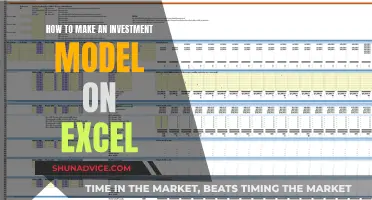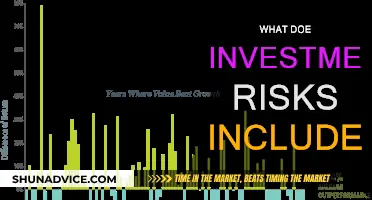
Tilting a portfolio is an investment strategy that overweighs a particular investment style. For example, tilting towards small-cap stocks or value stocks, which have historically delivered higher returns than the stock market. The three-factor model, developed by Nobel Laureate Eugene Fama and Professor Kenneth French, hypothesised that a stock's size and its book-to-price ratio also contribute to its expected return.
Since 1926, small-cap stocks have outperformed large-cap stocks by 1.6-1.7% per year, while value stocks have outperformed growth stocks by 3.0% per year. These differences in return are known as the small-cap and value premiums.
However, tilting is not recommended for new investors as it intentionally deviates from investing in the total market. It is also more expensive to invest in small-cap value stock index funds than total stock market index funds, and there is a higher risk of underperformance.
| Characteristics | Values |
|---|---|
| What is a portfolio tilt? | Industry slang for an investment strategy that overweighs a particular investment style. |
| What is a small-cap stock? | A stock whose market capitalization is in the bottom 10% of the total market. |
| What is a value stock? | A stock whose book-to-market ratio is in the top 30% of the total market. |
| What is the Fama-French Three-Factor Model? | A model that explains the risk and return of diversified equity portfolios across three risk dimensions: market risk, size risk, and value risk. |
| What is the rationale behind tilting a portfolio toward value and small-cap stocks? | The expectation of achieving a higher return or higher risk-adjusted return than the market. |
| What is the evidence supporting the small-cap and value tilting strategy? | Empirical studies and historical data showing that small-cap and value stocks have outperformed large-cap and growth stocks over the long term. |
| What are the potential benefits of tilting a portfolio toward value and small-cap stocks? | Higher expected returns, improved risk-adjusted returns, and reduced overall equity exposure while maintaining the same expected return for the portfolio. |
| What are the potential risks and considerations of tilting a portfolio toward value and small-cap stocks? | Increased costs, higher risk, tracking error with the overall market, underperformance during certain periods, and behavioural challenges. |
| Who is tilting suitable for? | Advanced investors who are knowledgeable, understanding of the risks, willing to accept higher risk, and disciplined in implementation and maintenance. |
What You'll Learn
- Small-cap and value stocks have historically outperformed large-cap and growth stocks
- The three-factor model: market risk, size risk, and value risk
- The Fama-French three-factor model
- The risk story: small value stocks are riskier than other stocks
- The behavioural bias: small value stocks are boring but profitable

Small-cap and value stocks have historically outperformed large-cap and growth stocks
Small-cap stocks, valued between $300 million and $2 billion, offer higher growth potential than large-cap stocks. They have the potential to maximise returns, as it is easier for a smaller company to double its revenue. For example, Amazon and Netflix were once small-cap stocks, and if you had bought and held these stocks when they were small, your investment would have appreciated more than 100 times.
Small-cap stocks tend to have higher growth rates and can benefit from lower interest rates, which can stimulate economic recovery and boost investment appeal. They can also be advantageous during periods of strong economic growth. However, they are more vulnerable to recessions, market crashes, and other shocks, and they are followed by fewer investors and analysts, so they can be more volatile.
Value stocks are considered to be companies that are currently trading below what they are worth and will thus provide a superior return. They are usually larger, more well-established companies that trade below the price that analysts feel the stock is worth, depending on the financial ratio or benchmark used as a comparison. Value stocks typically trade at a discount to either the price-to-earnings (P/E), book value, or cash flow ratios.
The Fama-French Three-Factor Model explains the risk and return of diversified equity portfolios across three risk dimensions: market risk, size risk, and value risk. This model forms the basis for tilting portfolios toward small-cap and value stocks. According to the model, tilting toward small-cap and value stocks provides a different return path than holding only the capitalization-weighted market itself.
While small-cap and value stocks have historically outperformed large-cap and growth stocks, it is important to note that past performance does not guarantee future results. Additionally, tilting portfolios can be risky and require long holding periods. Investors must be able to hold their allocation during periods when the tilted portfolio underperforms the market.
Private Investment: When Planning Exceeds Saving
You may want to see also

The three-factor model: market risk, size risk, and value risk
The three-factor model, also known as the Fama-French Three-Factor Model, is a well-known investment portfolio strategy. It was developed by Nobel Laureate Eugene Fama and Professor Kenneth French in 1992. The three-factor model expands on the Capital Asset Pricing Model (CAPM) by adding two additional factors: size risk and value risk. These factors are combined with the market risk factor in CAPM to provide a more comprehensive understanding of investment risk and return.
The three factors of the model are:
- Market Risk: This factor considers the sensitivity of a portfolio to the overall stock market. It is measured using the "beta" of a security, which indicates the volatility or systematic risk of an investment in relation to the market as a whole. A beta greater than 1 indicates higher volatility, while a beta less than 1 suggests lower risk.
- Size Risk: This factor accounts for the size of firms, specifically focusing on publicly traded companies with small market capitalizations (small-cap stocks). Small-cap stocks tend to generate higher returns but also carry higher risks.
- Value Risk: This factor considers book-to-market values, comparing high book-to-market ratio stocks (value stocks) with low book-to-market ratio stocks (growth stocks). Value stocks tend to outperform growth stocks and provide higher returns.
The three-factor model is based on the hypothesis that a stock's expected return is influenced not only by market risk but also by its size and book-to-price ratio. By incorporating these additional factors, the model can explain up to 95% or more of the variability in market returns. This makes it a valuable tool for investors to construct portfolios that align with their risk tolerance and expected returns.
Investors who employ the three-factor model in their portfolios may choose to overweight small-cap and value stocks, believing that these stocks will provide higher returns over time. However, it is important to note that tilting a portfolio towards small-cap and value stocks comes with additional risks and may not be suitable for all investors.
Consumption, Savings, and Investment: Understanding Aggregate Behavior
You may want to see also

The Fama-French three-factor model
- Market excess return
- The outperformance of small versus big companies
- The outperformance of high book/market versus low book/market companies
The model considers that value and small-cap stocks tend to outperform markets regularly. By including these two additional factors, the model adjusts for this outperforming tendency, making it a better tool for evaluating manager performance.
The Fama-French model is the result of an econometric regression of historical stock prices. Fama and French's research found that value stocks outperform growth stocks, and small-cap stocks tend to outperform large-cap stocks. As an evaluation tool, the performance of portfolios with a large number of small-cap or value stocks would be lower than the CAPM result, as the three-factor model adjusts downward for observed small-cap and value stock outperformance.
The three factors used in the model are:
- SMB (small minus big), which accounts for publicly traded companies with small market caps that generate higher returns.
- HML (high minus low), which accounts for value stocks with high book-to-market ratios that generate higher returns compared to the market.
- The portfolio's return less the risk-free rate of return.
Liquidating an Inherited Investment Portfolio: A Comprehensive Guide
You may want to see also

The risk story: small value stocks are riskier than other stocks
Small-cap and value stocks are considered riskier than other stocks, and this riskiness is reflected in the potential for higher returns. Small-cap stocks are generally defined as having market capitalisations (market caps) of about $300 million to $2 billion. They are considered riskier investments than large-cap stocks because they are less liquid, have less access to capital, and have less operational history. They are also more vulnerable to negative events and bearish sentiments due to their smaller size and resource disadvantages.
Small-cap stocks have less liquidity, which means that enough shares at the right price may be unavailable when an investor wishes to buy, or it may be difficult to sell shares quickly at favourable prices. They also have less access to capital, which can make it difficult for them to obtain financing for new market growth pursuits or to bridge gaps in cash flow. This problem can become more severe during economic downturns.
Additionally, small-cap stocks have less operational history, making it difficult to evaluate their potential for success. They are also more vulnerable to consumer preference changes because they do not have established, loyal customer bases. The lack of publicly available data on small-cap companies further adds to the risk for potential investors.
Value stocks are considered riskier because they are believed to be less efficient than other stocks. The belief is that the stock's price does not incorporate all publicly available information, which can lead to higher risk. However, it's important to note that the risk associated with small-value stocks is not necessarily a bad thing. The higher risk is often accompanied by the potential for higher returns. By tilting a portfolio towards small-cap and value stocks, investors can take advantage of the potential for increased returns.
It is worth noting that the decision to tilt a portfolio towards small-cap and value stocks is not suitable for all investors. Tilting is generally intended for advanced investors and can be risky for those who are new to investing. It is important for investors to carefully consider their risk tolerance and investment goals before deciding to tilt their portfolio.
Inflation's Impact: Protecting Your Investment Portfolio
You may want to see also

The behavioural bias: small value stocks are boring but profitable
Small-value stocks are a class of shares that fall under the category of small-cap stocks and are also considered value stocks. Small-cap stocks are shares of companies that have raised less than $2 billion in market capitalisation and are trading low relative to a given valuation model. Value stocks are those that are undervalued or when the market perceives their worth to be less than their intrinsic value.
Small-value stocks are often considered boring but can be profitable. According to the Fama-French Three-Factor Model, small-value stocks have two important qualities: size and value. Small-cap stocks tend to outperform the markets over large-cap stocks because they generally have a greater opportunity to grow. They are more under-the-radar and agile, allowing them to develop and leverage new technologies effectively.
Value stocks provide steady gains in revenue and profits, even if the company's business is in decline. They are typically stable, sometimes even boring, businesses that generate small but consistent revenue and profit growth. Value stocks are also known for paying healthy dividends, making them attractive to investors seeking a source of income.
However, it is important to note that small-value stocks may be challenging to find as they must meet both the small-cap and value stock criteria. Additionally, small-value stocks may carry greater risk over time as they may have a higher chance of failure compared to larger, more established companies.
When considering whether to tilt your investment portfolio towards small-value stocks, it is crucial to recognise that past performance does not guarantee future results. Small-value stocks may offer higher returns, but they also come with higher risks. It is essential to carefully evaluate your financial goals, risk tolerance, and investment horizon before making any decisions.
Our Social Security Savings: Where Are They Invested?
You may want to see also
Frequently asked questions
A portfolio tilt is an investment strategy that overweighs a particular investment style. For example, tilting to small-cap stocks or value stocks.
The research behind a small-cap and value tilt is based on the Three-Factor Model by Nobel Laureate Eugene Fama from the University of Chicago Booth School of Business and Kenneth French from Dartmouth College. Their model explains the risk and return of diversified equity portfolios across three risk dimensions: market risk, size risk, and value risk.
Investors who employ a small-cap and value tilt believe that overweighting small-cap stocks and value stocks provides a different return path than holding only the capitalization-weighted market itself. They believe that small-cap and value stocks are riskier and that the higher returns compensate investors for higher risk.
Some practitioners claim that a small-cap and value tilt is a more efficient way to invest, providing higher returns without higher risk. Tilting may also decrease diversification, increase costs, and make it difficult to stick with your portfolio due to tracking error with the overall market.







